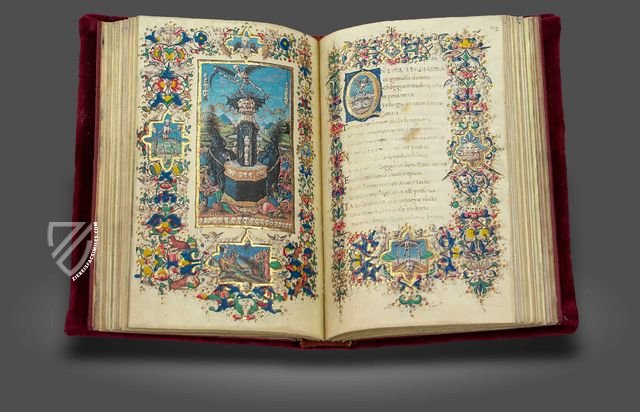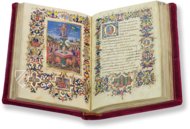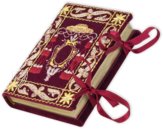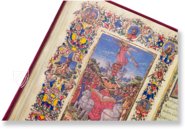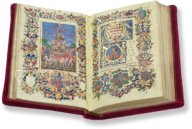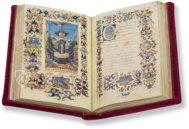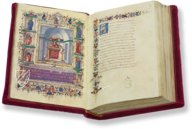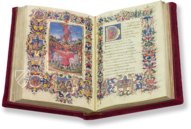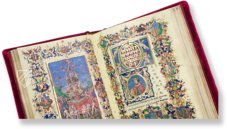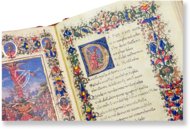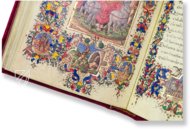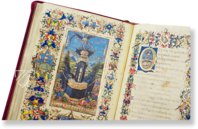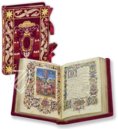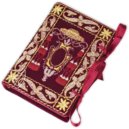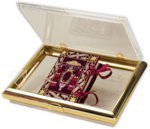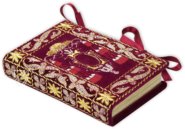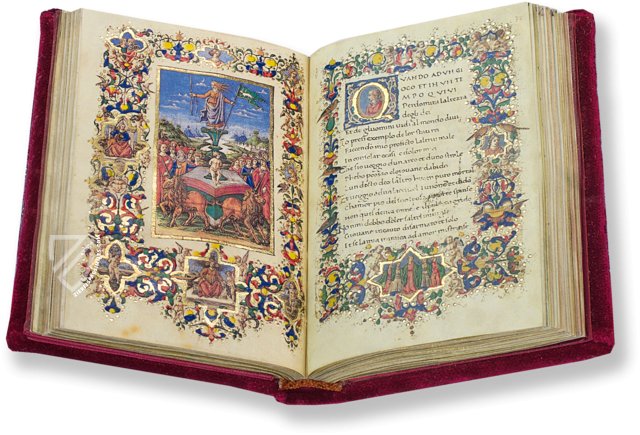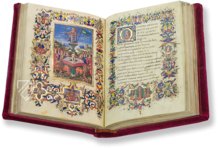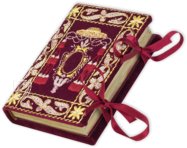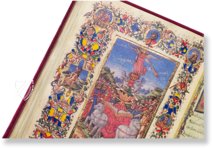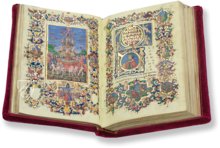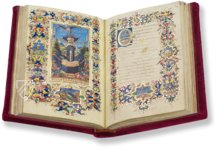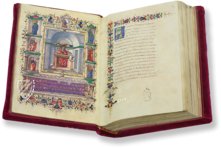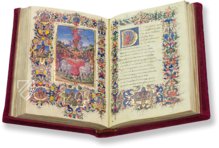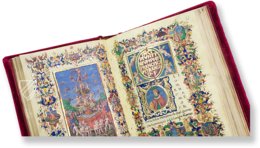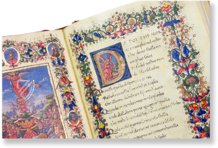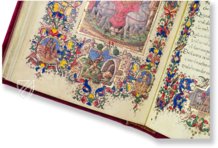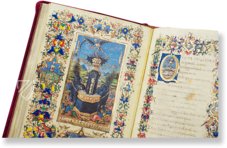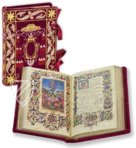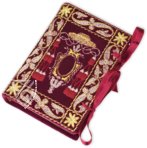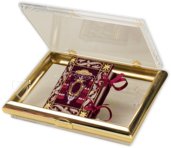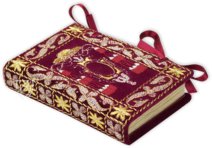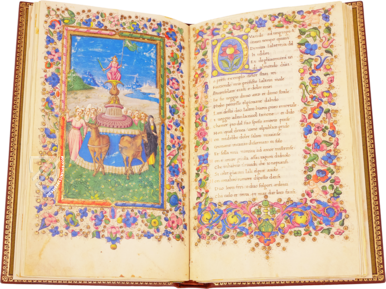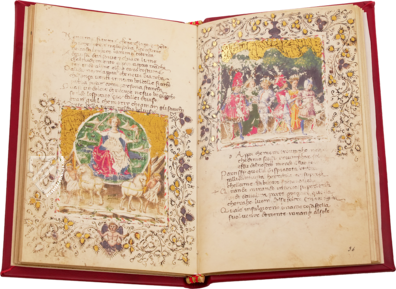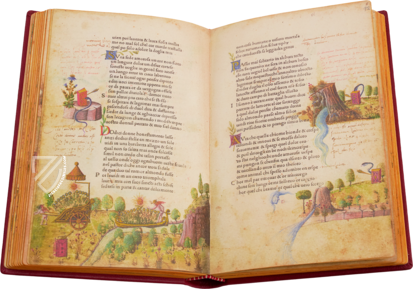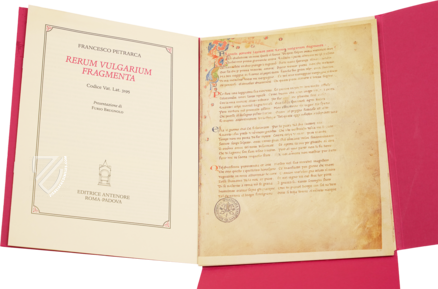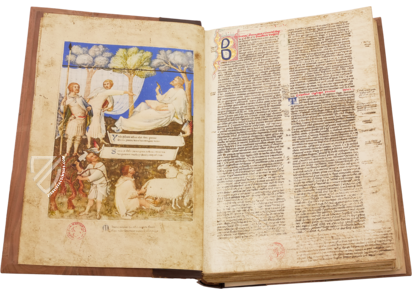Petrarca: Trionfi - Spain Codex
(1,000€ - 3,000€)
Petrarch's Trionfi are among the most popular literary works of the Renaissance. In it, the great poet of the early Italian Renaissance sings of the triumph of Love, Chastity, and Glory, the triumph of Time, the triumph of Death over Time, and the triumph of Eternity, thus setting forth his humanistic worldview entirely in the spirit of his time. Each of the Triumphs is introduced by a magnificent full-page miniature and the codex received a splendid red velvet binding with a cardinal’s hat from its last owner, the famous bibliophile and Vatican librarian and archivist Cardinal Francesco Saverio de Zelada. However, the identity of the artist who illuminated this small masterpiece in 15th century Italy remains a matter of debate among researchers.
Petrarca: Trionfi – Spain Codex
Despite its small side, this outstanding manuscript is furnished with extraordinarily refined miniatures as well as historiated initials and frames with an unbelievable level of detail that were made from refined color palette and plenty of gold. The seven full-page miniatures appear at the beginning of each Triumph, the titles appear in gold, and blue and gold initials mark the beginning of new sections. Aside from the text of the Trionfi, this manuscript also contains a Vita concerning Petrarch, a poem written in terza rima with examples of some of the Triumphs and descriptions of biblical and historical figures. These figures serve as examples for the universal themes that Petrarch explores in the text, such as the nature of time and what the true meaning of love is. This small manuscript unites one of the most important literary works of the 14th century with the magnificence of Italian Renaissance art!
Journey to Spain
The manuscript came into the possession of Cardinal Francesco Saverio de Zelada (1717–1801) during his time at the Papal Curia in Rome, but its history before remains mostly a mystery. It is assumed that it was at his behest that the codex was rebound and given its current binding of sumptuous red velvet with gold and silver threads forming a cardinal’s hat, which is kept close by strands of silk that can be tied. Zelada was not known for his piety but rather for his fines tastes as an antiquarian and collector of books, coins, medals, various works of art, and even scientific machines. He was appointed Librarian of the Holy Roman Church on the 15th of December 1779, a position he held for the rest of his life. This copy of the Trionfi was sent to Spain along with the rest of his collection of manuscripts in the late-18th century. After being part of the collections of the Toledo Cathedral Library, it found its way into the National Library in Madrid, where it remains today.
Debate Concerning the Artist
The identity of the talented master responsible for this gem of 15th century Italian book art remains a topic of debate. Some point to artistic similarities in another Trionfi manuscript that was illuminated by Francesco di Antonio del Chierico (1433–1484) for Lorenzo de Medici (1449–92) in 1475. These scholars to speculate that the favorite illuminator of the greatest art patron of Renaissance Italy was responsible for this manuscript as well. However, some of their colleagues have recently begun to put forward the name of another, less famous candidate: Riccardo di Nanni (fl. 1449–80). They argue that the technical details of the seven outstanding full-page miniatures are more indicative of the Florentine artist’s work. What everyone can agree on is that this is a small book treasure.
Codicology
- Alternative Titles
- Triunfos de Petrarca
Il Trionfi di Francesco Petrarca
Petrarch's Triumphs
Les Triomphes de Petrarque
Trionfi. Petrarca
Petrarca. Trionfi - Size / Format
- 158 pages / 11.5 × 7.5 cm
- Origin
- Italy
- Date
- 15th century
- Epochs
- Style
- Genre
- Language
- Script
- Humanist
- Illustrations
- 7 full-page miniatures, numerous decorative borders and historiated initials
- Content
- Petrarch's Triumphs
- Artist / School
- Author: Francesco Petrarca (1304–74)
Miniaturist: Ricciardo di Nanni (fl. 1449–80) or Francesco di Antonio del Chierico (1433–84) - Previous Owners
- Cardinal Zelada (1717–1801)
Petrarca: Trionfi - Spain Codex
Triumphus Mortis: Triumph of Death
The personification of Death stands atop a column adorned with skulls and bat wings in an elaborate triumphal chariot drawn by two black draft horses, precisely the kind used in funerary processions. Instead of flowers, his Via Triumphalis is strewn with the corpses of proud people from across history including emperors, popes, and great warriors. Although Petrarch only ascribes an actual triumphal chariot to Love, most illustrators chose to apply the device to all of the Trionfi.
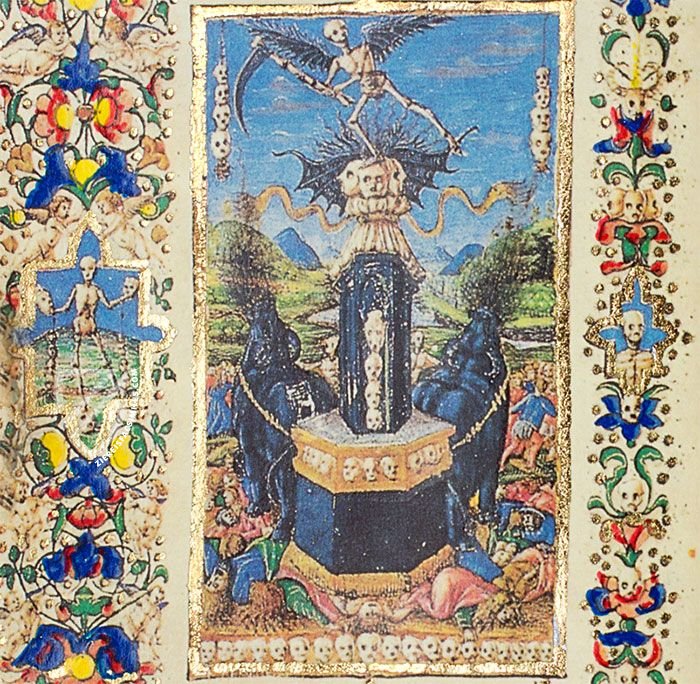
Petrarca: Trionfi - Spain Codex
Triumph of Chastity
Surrounded by a frame of medallion miniatures, fruits, flowers, cherubs, and birds rendered in rich primary colors and gold leaf, this miniature shows the personification of Pudicitia, the goddess of sexual virtue and Petrarch’s second triumph. Like in the rest of the codex, she is portrayed as though partaking in a Roman triumph, the procession enjoyed by victorious generals.
The maiden carries the bow and arrow of Cupid in her right hand as a spoil of war with the god himself handcuffed at her feet. In her left hand she raises a banner with an ermine on a green field – the color of the background symbolizes youth, the animal, innocence, the gold collar that leads to the neck, purity, and the topazes, temperance. Two unicorns draw the carriage.
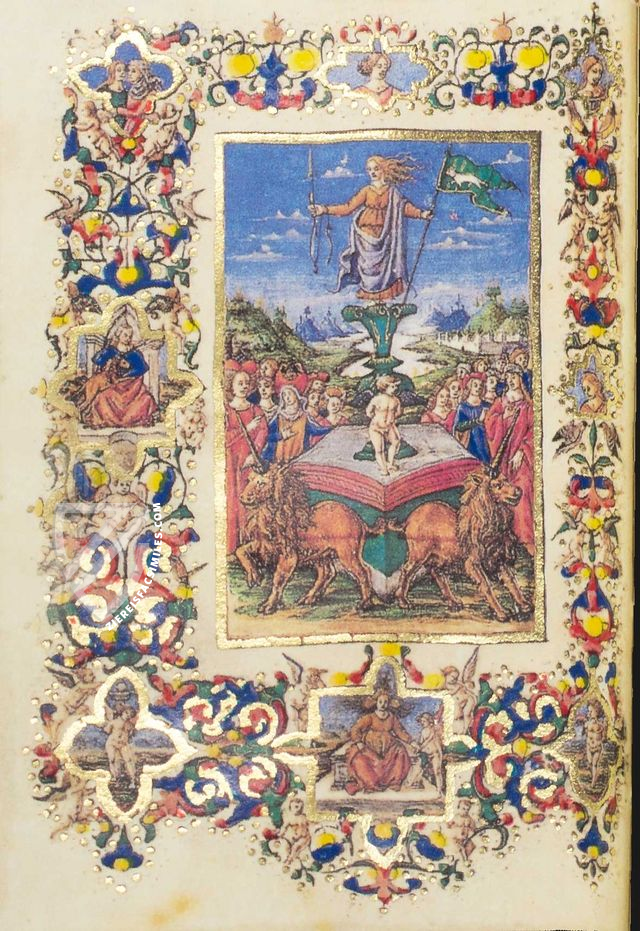
#1 Petrarca: Trionfi
Languages: Spanish or German or English
(1,000€ - 3,000€)
- Treatises / Secular Books
- Apocalypses / Beatus
- Astronomy / Astrology
- Bestiaries
- Bibles / Gospels
- Chronicles / History / Law
- Geography / Maps
- Saints' Lives
- Islam / Oriental
- Judaism / Hebrew
- Single Leaf Collections
- Leonardo da Vinci
- Literature / Poetry
- Liturgical Manuscripts
- Medicine / Botany / Alchemy
- Music
- Mythology / Prophecies
- Psalters
- Other Religious Books
- Games / Hunting
- Private Devotion Books
- Other Genres
- Afghanistan
- Armenia
- Austria
- Belgium
- Belize
- Bosnia and Herzegovina
- China
- Colombia
- Costa Rica
- Croatia
- Cyprus
- Czech Republic
- Denmark
- Egypt
- El Salvador
- Ethiopia
- France
- Germany
- Greece
- Guatemala
- Honduras
- Hungary
- India
- Iran
- Iraq
- Israel
- Italy
- Japan
- Jordan
- Kazakhstan
- Kyrgyzstan
- Lebanon
- Liechtenstein
- Luxembourg
- Mexico
- Morocco
- Netherlands
- Palestine
- Panama
- Peru
- Poland
- Portugal
- Romania
- Russia
- Serbia
- Spain
- Sri Lanka
- Sweden
- Switzerland
- Syria
- Tajikistan
- Turkey
- Turkmenistan
- Ukraine
- United Kingdom
- United States
- Uzbekistan
- Vatican City
- A. Oosthoek, van Holkema & Warendorf
- Aboca Museum
- Ajuntament de Valencia
- Akademie Verlag
- Akademische Druck- u. Verlagsanstalt (ADEVA)
- Aldo Ausilio Editore - Bottega d’Erasmo
- Alecto Historical Editions
- Alkuin Verlag
- Almqvist & Wiksell
- Amilcare Pizzi
- Andreas & Andreas Verlagsbuchhandlung
- Archa 90
- Archiv Verlag
- Archivi Edizioni
- Arnold Verlag
- ARS
- Ars Magna
- ArtCodex
- AyN Ediciones
- Azimuth Editions
- Badenia Verlag
- Bärenreiter-Verlag
- Belser Verlag
- Belser Verlag / WK Wertkontor
- Benziger Verlag
- Bernardinum Wydawnictwo
- BiblioGemma
- Biblioteca Apostolica Vaticana (Vaticanstadt, Vaticanstadt)
- Bibliotheca Palatina Faksimile Verlag
- Bibliotheca Rara
- Boydell & Brewer
- Bramante Edizioni
- Bredius Genootschap
- Brepols Publishers
- British Library
- C. Weckesser
- Caixa Catalunya
- Canesi
- CAPSA, Ars Scriptoria
- Caratzas Brothers, Publishers
- Carus Verlag
- Casamassima Libri
- Centrum Cartographie Verlag GmbH
- Chavane Verlag
- Christian Brandstätter Verlag
- Circulo Cientifico
- Club Bibliófilo Versol
- Club du Livre
- CM Editores
- Collegium Graphicum
- Collezione Apocrifa Da Vinci
- Comissão Nacional para as Comemorações dos Descobrimentos Portugueses
- Coron Verlag
- Corvina
- CTHS
- D. S. Brewer
- Damon
- De Agostini/UTET
- De Nederlandsche Boekhandel
- De Schutter
- Deuschle & Stemmle
- Deutscher Verlag für Kunstwissenschaft
- DIAMM
- Droz
- E. Schreiber Graphische Kunstanstalten
- Ediciones Boreal
- Ediciones Grial
- Ediclube
- Edições Inapa
- Edilan
- Editalia
- Edition Deuschle
- Edition Georg Popp
- Edition Leipzig
- Edition Libri Illustri
- Editiones Reales Sitios S. L.
- Éditions de l'Oiseau Lyre
- Editions Medicina Rara
- Editorial Casariego
- Editorial Mintzoa
- Editrice Antenore
- Editrice Velar
- Edizioni Edison
- Egeria, S.L.
- Eikon Editores
- Electa
- Emery Walker Limited
- Enciclopèdia Catalana
- Eos-Verlag
- Ephesus Publishing
- Ernst Battenberg
- Eugrammia Press
- Extraordinary Editions
- Fackelverlag
- Facsimila Art & Edition
- Facsimile Editions Ltd.
- Facsimilia Art & Edition Ebert KG
- Faksimile Verlag
- Feuermann Verlag
- Folger Shakespeare Library
- Franco Cosimo Panini Editore
- Friedrich Wittig Verlag
- Fundación Hullera Vasco-Leonesa
- G. Braziller
- Gabriele Mazzotta Editore
- Gebr. Mann Verlag
- Gesellschaft für graphische Industrie
- Getty Research Institute
- Giovanni Domenico de Rossi
- Giunti Editore
- Graffiti
- Grafica European Center of Fine Arts
- Guido Pressler
- Guillermo Blazquez
- Gustav Kiepenheuer
- H. N. Abrams
- Harrassowitz
- Harvard University Press
- Helikon
- Hendrickson Publishers
- Henning Oppermann
- Herder Verlag
- Hes & De Graaf Publishers
- Hoepli
- Holbein-Verlag
- Houghton Library
- Hugo Schmidt Verlag
- Idion Verlag
- Il Bulino, edizioni d'arte
- ILte
- Imago
- Insel Verlag
- Insel-Verlag Anton Kippenberger
- Instituto de Estudios Altoaragoneses
- Instituto Nacional de Antropología e Historia
- Introligatornia Budnik Jerzy
- Istituto dell'Enciclopedia Italiana - Treccani
- Istituto Ellenico di Studi Bizantini e Postbizantini
- Istituto Geografico De Agostini
- Istituto Poligrafico e Zecca dello Stato
- Italarte Art Establishments
- Jan Thorbecke Verlag
- Johnson Reprint Corporation
- Josef Stocker
- Josef Stocker-Schmid
- Jugoslavija
- Karl W. Hiersemann
- Kasper Straube
- Kaydeda Ediciones
- Kindler Verlag / Coron Verlag
- Kodansha International Ltd.
- Konrad Kölbl Verlag
- Kurt Wolff Verlag
- La Liberia dello Stato
- La Linea Editrice
- La Meta Editore
- Lambert Schneider
- Landeskreditbank Baden-Württemberg
- Leo S. Olschki
- Les Incunables
- Liber Artis
- Library of Congress
- Libreria Musicale Italiana
- Lichtdruck
- Lito Immagine Editore
- Lumen Artis
- Lund Humphries
- M. Moleiro Editor
- Maison des Sciences de l'homme et de la société de Poitiers
- Manuscriptum
- Martinus Nijhoff
- Maruzen-Yushodo Co. Ltd.
- MASA
- Massada Publishers
- McGraw-Hill
- Metropolitan Museum of Art
- Militos
- Millennium Liber
- Müller & Schindler
- Nahar - Stavit
- Nahar and Steimatzky
- National Library of Wales
- Neri Pozza
- Nova Charta
- Oceanum Verlag
- Odeon
- Orbis Mediaevalis
- Orbis Pictus
- Österreichische Staatsdruckerei
- Oxford University Press
- Pageant Books
- Parzellers Buchverlag
- Patrimonio Ediciones
- Pattloch Verlag
- PIAF
- Pieper Verlag
- Plon-Nourrit et cie
- Poligrafiche Bolis
- Presses Universitaires de Strasbourg
- Prestel Verlag
- Princeton University Press
- Prisma Verlag
- Priuli & Verlucca, editori
- Pro Sport Verlag
- Propyläen Verlag
- Pytheas Books
- Quaternio Verlag Luzern
- Reales Sitios
- Recht-Verlag
- Reichert Verlag
- Reichsdruckerei
- Reprint Verlag
- Riehn & Reusch
- Roberto Vattori Editore
- Rosenkilde and Bagger
- Roxburghe Club
- Salerno Editrice
- Saltellus Press
- Sandoz
- Sarajevo Svjetlost
- Schöck ArtPrint Kft.
- Schulsinger Brothers
- Scolar Press
- Scrinium
- Scripta Maneant
- Scriptorium
- Shazar
- Siloé, arte y bibliofilia
- SISMEL - Edizioni del Galluzzo
- Sociedad Mexicana de Antropología
- Société des Bibliophiles & Iconophiles de Belgique
- Soncin Publishing
- Sorli Ediciones
- Stainer and Bell
- Studer
- Styria Verlag
- Sumptibus Pragopress
- Szegedi Tudomànyegyetem
- Taberna Libraria
- Tarshish Books
- Taschen
- Tempus Libri
- Testimonio Compañía Editorial
- Thames and Hudson
- The Clear Vue Publishing Partnership Limited
- The Facsimile Codex
- The Folio Society
- The Marquess of Normanby
- The Richard III and Yorkist History Trust
- Tip.Le.Co
- TouchArt
- TREC Publishing House
- TRI Publishing Co.
- Trident Editore
- Tuliba Collection
- Typis Regiae Officinae Polygraphicae
- Union Verlag Berlin
- Universidad de Granada
- University of California Press
- University of Chicago Press
- Urs Graf
- Vallecchi
- Van Wijnen
- VCH, Acta Humaniora
- VDI Verlag
- VEB Deutscher Verlag für Musik
- Verlag Anton Pustet / Andreas Verlag
- Verlag Bibliophile Drucke Josef Stocker
- Verlag der Münchner Drucke
- Verlag für Regionalgeschichte
- Verlag Styria
- Vicent Garcia Editores
- W. Turnowski Ltd.
- W. Turnowsky
- Waanders Printers
- Wiener Mechitharisten-Congregation (Wien, Österreich)
- Wissenschaftliche Buchgesellschaft
- Wissenschaftliche Verlagsgesellschaft
- Wydawnictwo Dolnoslaskie
- Xuntanza Editorial
- Zakład Narodowy
- Zollikofer AG

